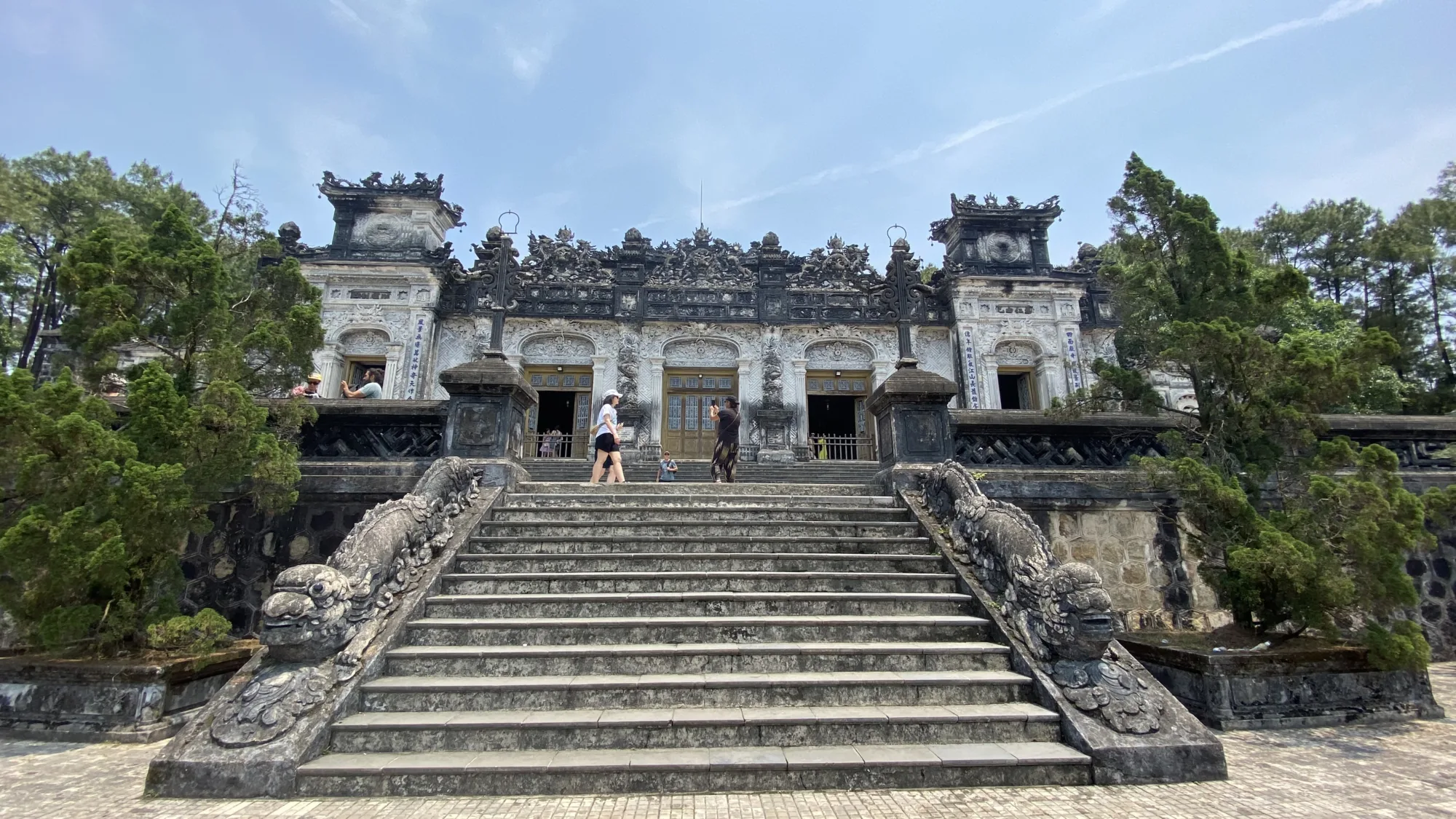Perched gracefully amidst the verdant hills of Vietnam’s Thua Thien Huế province lies the Mausoleum of Emperor Khai Dinh (Khải Định). This architectural gem, constructed in the early 20th century, stands as a poignant fusion of Eastern and Western influences. It showcases the rich cultural history of Vietnam and a nice prelude to the Imperial Citadel of Hue.
The design of the tomb occurred under the reign of Emperor Khai Dinh, who held power from 1916 to 1925. In fact, this grand structure reflects the emperor’s affinity for European aesthetics. Thus, it departs from the traditional Vietnamese architectural style of previous dynasties. In 1993, UNESCO designated the tomb as a World Heritage Site, recognized as an integral component of the Complex of Hue Monuments, including the Hue Tombs.
As we approached the mausoleum, a sense of awe washes over us. Its imposing facade, adorned with intricate motifs and elaborate detailing, hints at the opulence within. Rectangular in structure, the mausoleum stood tall against the backdrop of the Châu Chữ Mountain on the outskirts of Hue. Although it was a steep climb, it was a worthwhile activity, nonetheless, as the experience allowed us to know the life of Emperor Khai Dinh.









Emperor Khai Dinh: 12th emperor of the Nguyen Dynasty
Emperor Khai Dinh, born Prince Nguyễn Phúc Bửu Đảo, ascended to the throne at a pivotal moment in Vietnam’s history. Though he was the son of Emperor Đồng Khánh, he did not immediately succeed his father. Amidst the challenges of colonialism and modernization, he sought to modernize the country while preserving its cultural heritage. His reign saw significant reforms in administration, education, and infrastructure. Furthermore, he made efforts to strengthen Vietnam’s position on the global stage.
Despite his controversial collaboration with French colonial authorities, Emperor Khai Dinh’s legacy is complex and multifaceted. His fascination with Western art and culture, evident in the design of his mausoleum, reflects his aspiration to position Vietnam as a modern and cosmopolitan nation. However, resistance from traditionalists and nationalist movements marked his rule. In addition, it highlighted the tensions between tradition and modernity in Vietnamese society.
Emperor Khai Dinh was not only a ruler but also a passionate patron of the arts. True enough, his mausoleum stands as a testament to his patronage, showcasing the finest craftsmanship of the era. From the intricate carvings adorning its walls to the vibrant frescoes depicting Vietnamese history, every detail reflects the emperor’s appreciation for artistic excellence. Today, his mausoleum serves as a lasting tribute to his vision and legacy, inviting visitors to marvel at the artistic achievements of his reign.



The Interior Splendor of the Mausoleum of Emperor Khai Dinh
Stepping through the ornate gates, visitors enter into a realm of splendor and reverence. The interior of the mausoleum is a symphony of marble, mosaic, and stained glass, meticulously crafted to honor the legacy of Emperor Khai Dinh. The main chamber, adorned with vivid frescoes depicting scenes from Vietnamese mythology and history, captivates the imagination and invites contemplation.
One of the most striking features of the mausoleum is the tomb chamber itself, where the Emperor’s sarcophagus lies. Constructed over a period of 11 years, the chamber is a marvel of engineering and design. Also, it boasts of walls adorned with intricately crafted reliefs. Furthermore, its ceiling is filled with glass mosaics that reflect a kaleidoscope of colors when sunlight filters through.
However, the Mausoleum of Emperor Khai Dinh is not merely a tribute to imperial grandeur; it also symbolizes the resilience of Vietnamese culture in the face of colonial influence. Emperor Khai Dinh’s fascination with Western art and architecture was a response to the challenges posed by French colonial rule. Additionally, it represented a synthesis of East and West that remains a defining aspect of Vietnam’s cultural identity.












A Tranquil Retreat for Visitors
Beyond its historical and architectural significance, the mausoleum offers visitors a serene retreat amidst the lush landscapes of Hue. Surrounded by the commanding panoramic views of the countryside, it provides a tranquil space for reflection and contemplation.
Visitor Information:
- Entrance Fee: The entrance fee to the Mausoleum of Emperor Khai Dinh is typically around 150,000 VND (Vietnamese Dong) for adults, equivalent to approximately $6 USD. On the other hand, it is 30,000 VND or around $1.20 USD for children.
- Open Hours: The mausoleum is open to visitors from 8:00 AM to 5:00 PM daily. Better yet, arrive early to avoid crowds and fully appreciate the beauty of the site.
- How to Get There: The Mausoleum of Emperor Khai Dinh is located approximately 10 kilometers southeast of Hue city center. Visitors can reach the site by taxi, motorbike, or joining a guided tour. For us, we joined a Klook tour from Da Nang for convenience and comfort. The journey takes approximately 30 minutes by road from the city center, offering scenic views of the countryside along the way.
For those seeking to delve deeper into Vietnam’s imperial history and artistic heritage, a visit to the Mausoleum of Emperor Khai Dinh is an enriching experience. From its awe-inspiring architecture to its cultural symbolism, it stands as a testament to the enduring legacy of Vietnam’s past, inviting travelers to explore and discover the beauty of this historical treasure.


Link: https://artsandculture.google.com/asset/overview-of-khai-dinh-tomb-tran-tuan-viet/egHkZLUNQfnL3A
